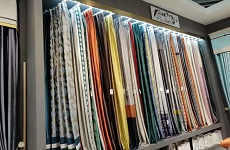我们为您准备“新鲜”的优质文献内容,本期为大家推送的领域:信息科学、医学科学、生命科学、工程与材料科学相关精选文献,欢迎您关注我们,随时获得最新推荐!
信息科学
高温超导体在EuTiO单层中的抗磁极化
作者:Chong Liu,Hyungki Shin,Ke Zou
摘要:
磁化自由度在非传统超导性中通常起着重要作用。在许多铁基化合物中,超导性在接近长距离抗磁有序时被发现,而增强超导性的单层FeSe在SrTiO3上生长,其表现没有磁或类似正交有序。在这里,我们在抗磁EuTiO3(001)层上生长单层和多层FeSe,以在FeSe的超导性附近引入磁化极化。通过X射线磁二极管,我们在Eu和Ti sites上观察到由应用磁场驱动的抗磁-铁磁切换,而Fe site of FeSe上没有相应的磁化极化。传输测量显示,在EuTiO3上,单层FeSe的超导性在~30K的转变温度下得到增强。通过光电子发射光谱观察到的电子结构类似于FeSe/SrTiO3。我们的工作为二维中磁化和非传统超导性的相互作用提供了一个平台。
Abstract:
Spin degree of freedom generally plays an important role in unconventional superconductivity. In many of the iron-based compounds, superconductivity is found in close proximity to long-range antiferromagnetic order, whereas monolayer FeSe grown on SrTiO3, with enhanced superconductivity, exhibits no magnetic or nematic ordering. Here we grow monolayer and multilayer FeSe on antiferromagnetic EuTiO3(001) layers, in an effort to introduce a spin polarization in proximity to the superconductivity of FeSe. By X-ray magnetic dichroism, we observe an antiferromagnet–ferromagnet switching on Eu and Ti sites in EuTiO3 driven by the applied magnetic field, with no concomitant spin polarization on the Fe site of FeSe. Transport measurements show enhanced superconductivity of monolayer FeSe on EuTiO3 with a transition temperature of ~30 K. The band structure revealed by photoemission spectroscopy is analogous to that of FeSe/SrTiO3. Our work creates a platform for the interplay of spin and unconventional superconductivity in the two-dimensional limit.
医学科学
ZIF-67的抗菌和抗生物膜活性
作者:Ramses Gallegos-Monterrosa,Rodrigo Orozco Mendiola,Víctor H. Bustamante
摘要:
目前,全球范围内的抗生素耐药菌对公共卫生构成了严重威胁。生物膜形成能够增强细菌的毒性和抗生素耐药性。因此,发现新的抗细菌和抗生物膜化合物对抗难以治疗的细菌感染至关重要。 Zeolitic-imidazolate-frameworks(ZIFs)是一种具有各种有趣化学和生物应用的金属有机化合物,包括抗细菌性能。在本研究中,我们合成了ZIF-67纳米颗粒,通过imidazolate阴离子和钴离子的形成,发现它们抑制了Acinetobacter baumannii、Pseudomonas aeruginosa和Staphylococcus aureus的生长。此外,ZIF-67的亚抑制浓度还能够显著降低这些致病细菌预先建立的生物膜的生物量。另一方面,ZIF-67纳米颗粒在那些具有抗细菌或抗生物膜活性的浓度下对哺乳动物细胞没有或只有轻微的细胞毒活性。因此,我们的结果表明,ZIF-67纳米颗粒具有对抗致病菌的潜在用途。
Abstract:
Currently, antibiotic-resistant bacteria represent a serious threat to public health worldwide. Biofilm formation potentiates both virulence and antibiotic resistance of bacteria. Therefore, the discovery of new antibacterial and antibiofilm compounds is an issue of paramount importance to combat and prevent hard-to-treat bacterial infections. Zeolitic-imidazolate-frameworks (ZIFs) are metallo-organic compounds known to have various interesting chemical and biological applications, including antibacterial properties. In this study, we synthesized ZIF-67 nanoparticles, formed by imidazolate anions and cobalt cations, and found that they inhibit the growth of Acinetobacter baumannii, Pseudomonas aeruginosa, and Staphylococcus aureus. Sub-inhibitory concentrations of ZIF-67 were also able to significantly reduce the biomass of pre-established biofilms of these pathogenic bacteria. On the other hand, the ZIF-67 nanoparticles had null or low cytotoxicity in mammalian cells at those concentrations showing antibacterial or antibiofilm activities. Thus, our results reveal the potential of ZIF-67 nanoparticles to be used against pathogenic bacteria.
生命科学
数据驱动的布尔模型解释了CD8+ T细胞耗竭中的记忆亚集和进化
作者:Geena V. Ildefonso,Stacey D. Finley
摘要:
T细胞在免疫应答中扮演关键角色,包括感染和癌症。在刺激下,naive CD8+ T细胞会增殖并分化成多种记忆和效应细胞类型;然而,无法清除抗原会导致CD8+ T细胞的持续刺激,最终导致T细胞耗竭(TCE)。然而,功能和表型的变化以及CD8+ T细胞分化的基因表达状态变化已经被充分描述,但背后的基因表达状态变化并不是完全理解的。在这里,我们利用了一个之前发表的基于数据驱动的布尔模型,该模型被证明可以调节TCE。我们的网络分析和建模揭示了与TCE相关的最终基因表达状态,以及导致这些最终状态的基因表达模式的序列。有了一个预测基因表达变化导致TCE的模型,我们可以评估抑制TCE耗竭状态的策略。总的来说,我们证明了共性途径模型CD8+ T细胞基因 regulatory interactions可以为了解TCE中细胞状态的进化提供洞察。
Abstract:
T cells play a key role in a variety of immune responses, including infection and cancer. Upon stimulation, naïve CD8+ T cells proliferate and differentiate into a variety of memory and effector cell types; however, failure to clear antigens causes prolonged stimulation of CD8+ T cells, ultimately leading to T cell exhaustion (TCE). The functional and phenotypic changes that occur during CD8+ T cell differentiation are well characterized, but the underlying gene expression state changes are not completely understood. Here, we utilize a previously published data-driven Boolean model of gene regulatory interactions shown to mediate TCE. Our network analysis and modeling reveal the final gene expression states that correspond to TCE, along with the sequence of gene expression patterns that give rise to those final states. With a model that predicts the changes in gene expression that lead to TCE, we could evaluate strategies to inhibit the exhausted state. Overall, we demonstrate that a common pathway model of CD8+ T cell gene regulatory interactions can provide insights into the transcriptional changes underlying the evolution of cell states in TCE.
工程与材料科学
利用角分辨光发射光谱在单轴应变下揭示纳米材料中的Nematicity
作者:S. Nakata,M. Horio,A. Fujimori
摘要:
铜合金超导体中,伪隙态的性质及其与超导性的关系是研究的核心问题。最近,提出了一个可能的 scenarios,即伪隙态是一种基于运输和磁化率测量的自旋对称破缺的“类似正交”相,在伪隙温度T*以下观察到对称破缺。在这里,我们报道了一项关于沿Cu-O键方向施加单轴应变略微超导体Bi1.7Pb0.5Sr1.9CaCu2O8+δ中自旋对称破缺的温度依赖ARPES研究。与以前的研究一样,在伪隙态中,自旋对称破缺增强,而在超导态中,自旋对称破缺被抑制。这些结果表明,伪隙态具有自旋对称破缺的特征,而自旋对称破缺可能与超导性竞争。关于伪隙态中自旋对称破缺与电荷密度波的关系,以及它们在伪隙态中都被观察到的结果,进行了讨论。
Abstract:
The nature of the pseudogap and its relationship with superconductivity are one of the central issues of cuprate superconductors. Recently, a possible scenario has been proposed that the pseudogap state is a distinct phase characterized by spontaneous rotational symmetry breaking called “nematicity” based on transport and magnetic susceptibility measurements, where the symmetry breaking was observed below the pseudogap temperature T∗. Here, we report a temperature- dependent ARPES study of nematicity in slightly overdoped Bi1.7Pb0.5Sr1.9CaCu2O8+δ triggered by a uniaxial strain applied along one of the Cu–O bond directions. While the nematicity was enhanced in the pseudogap state as in the previous studies, it was suppressed in the superconducting state. These results indicate that the pseudogap state is characterized by spontaneous rotational symmetry breaking and that the nematicity may compete with superconductivity. Relationship between the nematicity and charge-density waves, both of which are observed in the pseudogap state, is discussed.











